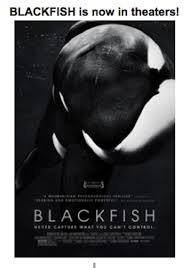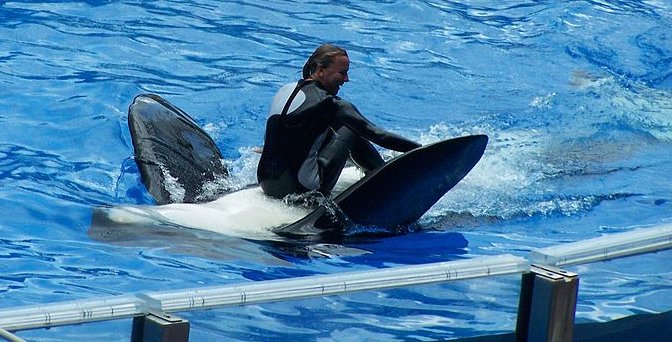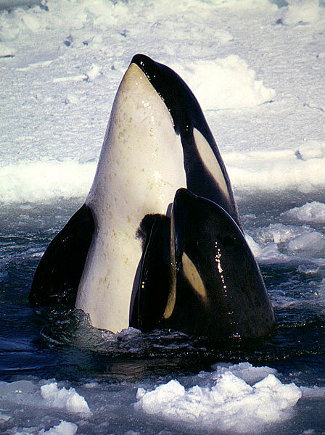BlackFish - Death at Seaworld

Blackfish tells the heartbreaking and shocking story of Tilikum, an orca who was torn from his family in the wild and imprisoned in a concrete bathtub at SeaWorld, where he made headlines after killing trainer Dawn Brancheau in 2010. After more than 30 years in captivity, he lashed out in frustrated rage, drawing worldwide attention to SeaWorld’s practice of imprisoning sensitive, intelligent marine mammals and denying them everything that is natural and important to them.
Screaming orca fated for SeaWorld urges public to watch Blackfish
BlackFish – official trailer
Attracting up to 12 million visitors a year across the three locations, SeaWorld was rocked by Brancheau's death after Orca whale Tilikum dragged her by her ponytail into the water, scalped her and dismembered her.

Officials claimed trainer Mrs Brancheau's hair brushed the nose of the killer whale, called Tillikum, as she petted him in a pool (2010).
Mrs Brancheau, an experienced trainer, was lying down in a few inches of water with her head close to the whale when it reached across to grab her hair.
The whale grabbed the 40-year-old married trainer in its awesome jaws and held her until she drowned. The death was witnessed by up to 50 tourists.
Kidnapped Marine Wildlife
Kidnapping marine life from the ocean, removing them from their families, imprisoning them for life, and forcing them to perform tricks for people who pay $75 a ticket is not about educating the public as Sea World would have you believe; it's all about profits.
John Crowe, a former diver, explains the kidnapping process in one of the most poignant interviews in Blackfish. In 1970, he was involved in a kidnapping operation in Puget Sound, Washington. When he and the other hunters tried to get the baby orcas into a stretcher, the family was in a big line communicating and refused to leave when their nets were removed.
At that point, he realized he was kidnapping a child from its mother. On the verge of tears, he said it was the worst thing he'd ever done.

Unbeknown to the the victim, and the public, Dawn Brancheau was not Tilikum's first casualty.
In 1991, trainer Keltie Lee Byrne fell into a tank holding Tilikum and two other whales at Sealand of the Pacific in Victoria, Canada. A homicide inquest found that the whales had prevented Byrne from climbing out of the tank and ruled her death an accident.
Soon afterwards he was sold to SeaWorld where he sired 12 calves.
In 1999, 27-year-old homeless Daniel Dukes was found dead and nude, draped over Tilikum’s back. He had stayed until SeaWorld closed for the evening, evaded security and managed to get into the tank.
"Death at Seaworld"
Death at SeaWorld is written by New York City reporter David Kirby, who claims that killer whales kept in captivity suffer immense emotional and psychological trauma and spoke to former trainers and campaigning animal rights advocates to present his damning case. Staff interviewed by Kirby told him of killer whales destroying their teeth on metal gates and then subsequently having those teeth removed by staff wielding power drills.
He claims that calves are separated from their mothers, causing both parent and child massive distress and in one instance almost leading to a fatality as an irate mother took out her anger on a trainer at SeaWorld's San Diego headquarters.
There are no known records of killer whales attacking humans in the wild, while even mild aggression towards trainers at close quarters is not uncommon.
Orcas are inherently wild animals, and their size, behaviours, psychologically damaging capture, separation from their mothers and pods, and having to be confined in bath-tub sized aquariums, makes them unsuitable for training, displays for human entertainment. It seems that people like to see wild animals “perform”, in a submissive display of dominance.
MRI scans have revealed that Orca whales have a large component of their brain used for processing emotions. They have a language, they move in large interconnected families and, as one hunter said, ‘they know what is going on.’ The wails are nothing more than the sounds of excruciating grief.
Killer whales are incredibly beautiful, intelligent and emotional animals. They simply do not deserve to be ripped away from their families and kept in restrictive concrete pools for the entertainment of humans. Keeping animals in captivity is bad, but the depth to which it damages and arguably destroys them, and they become self-destructive and spontaneously violent.
The Australian Sea World doesn’t have orca whales, but it does have dolphins and a baby polar bear – all of whom I reckon would rather not be kept in enclosures in Queensland.
Things at SeaWorld are not looking good—even its owners are jumping ship. Following declining ticket sales and a public outcry over the documentary Blackfish, the chair of SeaWorld's board of directors David D'Alessandro sold 43,179 shares of the company's stock.

Recent comments